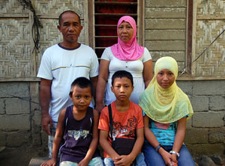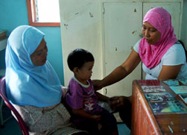
A wife and loving mother of five, Rowena Osama, 40, has lived in the Philippines' Sarangani province since 1986. She delivered her five children at home through the help of a village healer, known locally as an arbulario. She recounts that her first delivery was difficult. "It was incredibly painful and there was a lot of blood," Rowena shares.
Her second delivery was even more complicated. Sitti Hayla, her second child who is now 15, almost died. "I was crying aloud with fear of losing her. Thank God she survived," recalls Rowena. The village healer used herbal medicines to assist in her delivery. "It's a cultural thing, but I realized that it isn't safe. I'm thankful my Sitti -- and the rest of my kids -- made it."

Despite her busy schedule, Rowena Osama loves and cares for her own family while she pours herself into service in the community. Photo: Crislyn Felisilda/World Vision
Maternal mortality
Two years ago, Rowena witnessed the tragic death of a friend after she gave birth. "Before that, most pregnant women in our community did not visit the health center for prenatal or postnatal care. Moreover, when their children got sick, they resorted to using self-prescribed medication only," she adds.
In most Muslim communities on Mindanao Island, women generally have 10 or more children. Unfortunately some babies, and even mothers themselves, die before or after the delivery due to various complications. "The lack of prenatal care played a role in the poor health of the children," Rowena says.
Medical records of the Sarangani Provincial Health Office show that the major cause of maternal mortality was a retained placenta. "Inadequate primary health care and insufficient health services, coupled with socioeconomic instability in poor regions of Mindanao, all contribute to this bleak outlook for mothers and their infants," says Jennifer Sapuiz, World Vision health development staff member.
"Low level of competence among local health practitioners as well as lack of community awareness on health issues result in significant complications of maternal and child health," adds Sapuiz.
Empowering community health workers
In response to maternal mortality, World Vision -- in partnership with the local health office -- conducted training on Inter-Personal Communication and Counseling Skills to help improve maternal and child health care. The goal of the training was to facilitate behavior change among mothers, so that they would be willing to seek health services at the village health centers. World Vision also distributed pediatric equipment to the health facilities working on maternal and child health in Sarangani.
After learning about nutrition, maternal and child care, Rowena actively advocated for others to recognize the importance of providing care for women and children. Now every week Rowena gathers mothers to discuss maternal and child care. "More than half of the pregnant women in our community regularly attend buntis (pregnancy) class," says Rowena. "More mothers deliver babies in the health centers now."
In conservative Muslim communities, where newly married couples usually live in their parents' homes, Rowena made extra effort to encourage women to learn more about maternal, child care and nutrition, especially those who are unfamiliar with prenatal and postnatal care. She discovered that the mothers-in-law of young women also benefit from effective postnatal counseling sessions. "Once they understand the benefits, they encourage their daughters to visit the clinic. This way, we reach more women," she shares.
A mom and a leader

After learning about nutrition, maternal and child care, Rowena actively advocated for others to recognize the importance of providing care for women and children. Now every week Rowena gathers mothers to discuss maternal and child care.
Photo: Crislyn Felisilda/World Vision
Aside from being an active village health worker, Rowena also is a World Vision community volunteer. She regularly monitors the well-being of the children in her community. "Parents should know the nitty-gritty of taking care of themselves, especially their children. Ailing parents couldn't support their families. Sickly and malnourished children couldn't attend schools, setting back their education," Rowena added.
Despite her busy schedule, Rowena loves and cares for her own family while she pours herself into service in the community. She wakes up early in the morning to prepare breakfast for her family, making sure the house is clean and that the dishes are washed before heading out to the village clinic.
Rowena is thankful that Sitti Hanina, 14, her third child, became a World Vision sponsored child because that has helped out the entire family. Her husband drives a public utility tricycle to provide the family with a day-to-day income; earning only about $2-$3 daily doesn't always suffice, however. "World Vision is a big blessing to my family," she shares.
Rowena gives back by actively serving others to ensure that proper health and nutritional practices offer the greatest benefit to mothers and their children. She believes that education is the only antidote to poverty. "We're grateful for the training and support that World Vision provided," says Rowena. "We enjoy listening to the cries of newborn babies, especially because now they are healthy cries. They are cries of life."
What You Can Do
- Pray for the work of volunteer health advocates around the world, that their important information will be embraced by mothers and lead to better health and well-being for families, and that they will be a source of blessing and encouragement in their communities.